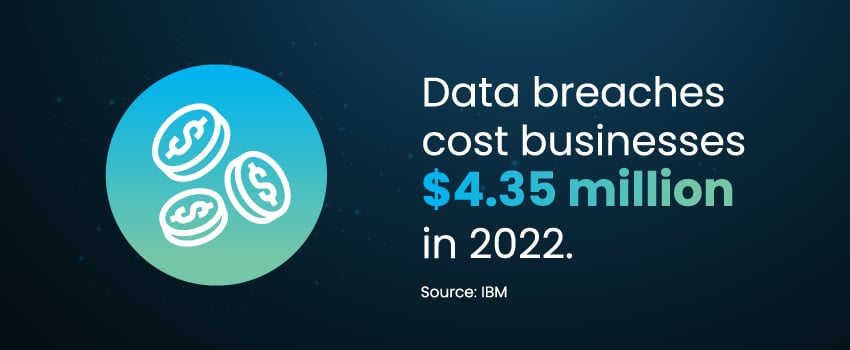Today’s businesses face a wide range of supply chain risks that can impact their operations, from geopolitical events to natural disasters and more. One of the biggest risks plaguing modern supply chains, however, is cybersecurity. A recent survey found that 98% of enterprises have experienced a data breach targeting cybersecurity vulnerabilities in their supply chains.1
Data breaches reached a global average total of $4.35 million last year,2 so securing your supply chain from cybersecurity risks should be a top priority for businesses of all sizes. Luckily, supply chain risk management (SCRM) can help protect your supply chain from costly cyber threats. Keep reading to learn the basics of SCRM and get tips for creating an effective SCRM strategy.
What Is Supply Chain Risk Management?
Supply chain risk management involves identifying, assessing, and mitigating any risks that can affect an organization’s supply chain, including risks related to:
- Third-party suppliers
- Logistics networks
- Transportation networks
- Distribution channels
Effective SCRM involves leveraging technology and data analytics to improve visibility and control over the supply chain. As a result, companies also gain the ability to quickly detect and respond to potential risks before they have a chance to impact operations.
By incorporating SCRM, businesses can ensure their supply chains continue functioning even during unexpected events, such as cyberattacks or natural disasters. SCRM strategies can also help organizations run more efficiently, reduce costs, and improve customer service.

Cybersecurity Best Practices for Supply Chain Risk Management
Supply chain risks can create cybersecurity vulnerabilities, so SCRM and cybersecurity are closely related concepts. As supply chains become more complex and dependent on technology, the risk of cyberattacks and third-party breaches increases. That’s why integrating cybersecurity into the supply chain risk management process is so important
Consider incorporating these cybersecurity best practices when developing your SCRM strategy:
- Build a strong foundation - SCRM encompasses both cybersecurity and supply chain risk management, so before you can implement an SCRM strategy, you’ll have to ensure your existing cybersecurity and supply chain practices are as effective as possible.
- Think organization-wide - An effective SCRM strategy involves every organizational tier within your company, so keep in mind that it’ll have to be implemented throughout every system’s lifecycle.
- Identify risks and threats - SCRM should be a part of your overall risk management strategy, alongside identifying and mitigating threats and vulnerabilities, properly documenting policies, and monitoring system performance.
- Protect your critical systems - To get the most value out of your SCRM practices, be sure to identify the systems, applications, and hardware that are most vulnerable and would cause the most damage to your company’s operations if compromised.
How Does ZTA Support SCRM?
Zero trust access (ZTA) can support supply chain risk management by providing a more secure framework for managing access to sensitive information and systems.
Traditionally, supply chains are managed using a perimeter-based security model, where access to the network is restricted to users and devices within a company’s physical offices. But with increased cloud adoption and 80% of employees currently working in a remote or hybrid environment,3 this model is no longer effective.
ZTA assumes that every user, device, and application within the network is untrusted and must be authenticated before providing access to sensitive resources. Businesses that implement ZTA can better manage access to their supply chain systems and reduce cybersecurity risks – regardless of where employees, third-party vendors, and subsidiary companies are located.
Safeguard Your Supply Chain With Safous ZTA
Businesses need SCRM to enhance supply chain resilience and reduce the risk of disruptions. By implementing effective SCRM practices, you can ensure your company’s operations – and your customers’ sensitive data – stay protected now and in the future.
Strengthen your SCRM strategy and gain full control over your network with Safous ZTA. Our easy-to-deploy ZTA platform provides integrated security tools such as multi-factor authentication (MFA), single sign-on (SSO), and application-based access to help protect supply chain data and applications from attack. Request a demo today to learn more.
Sources:
Receive the latest news, events, webcasts and special offers!
Share this
You May Also Like
These Related Stories

Secure Your Supply Chain Security with a Zero Trust Approach

5 Ways MSPs Can Improve Supply Chain Security With Zero Trust Access




